
Giuseppe Arcimboldo (Italy, 1527–1593)
La Primavera (Spring)
oil on canvas
76 x 63.5 cm. (29.9 x 25 in.)
painted in 1573
Part of a set of four paintings The Four Seasons by Giuseppe Arcimboldo
Collection of Louvre Museum, Paris, France

A set of four paintings The Four Seasons by Giuseppe Arcimboldo (Italy, 1527–1593)
While allegorical figures were in vogue during the Renaissance, Arcimboldo's originality lay in personifying an abstraction using a large number of concrete objects or elements of nature.
He thus created a series of four portraits representing the four seasons.
Approach Spring and observe the multitude of flowers that make up the young woman's portrait. Do you recognise them? Two rosebuds make up the delicate lips, the teeth are lily of the valley flowers, the nose is a still-closed flower bud, and a pink peony forms the ear. The hair is represented by a bouquet of varied flowers, from which a lily emerges at the back of the head. The ruff around her neck, fashionable in the 16th century, is a garland of daisies. An iris springs from a bodice of large leaves. A small wild strawberry at the base of the iris discreetly announces the arrival of summer.
The flowers framing the portrait were not painted by Arcimboldo, but were probably added in the 17th century.
Given to the Duke-Elector of Saxony by the German Emperor Maximilian II, it pays homage to a natural political order destined to perpetuate itself, like the spring that returns every year. The multitude of floral elements that combine in diversity to create the unity of the human figure is also highly symbolic of the Habsburg Empire, the family of Maximilian II, which was able to unite numerous territories.
Whether a poetic or political portrait, this surprising canvas sows the seeds of surrealism a few centuries ahead of its time...














